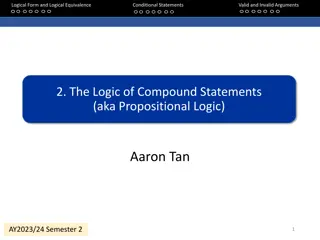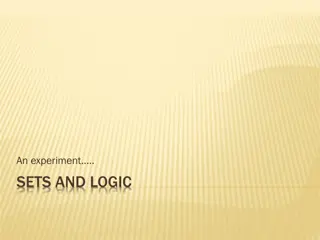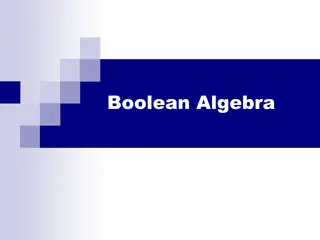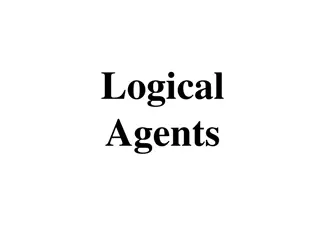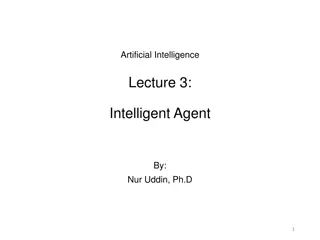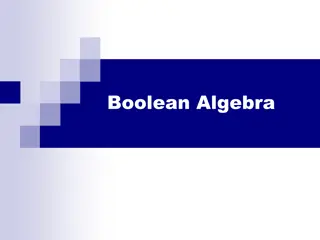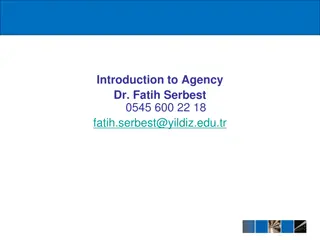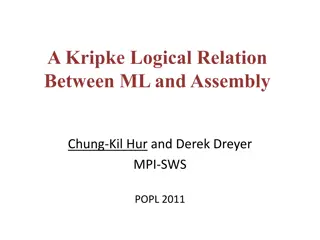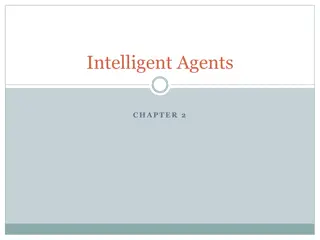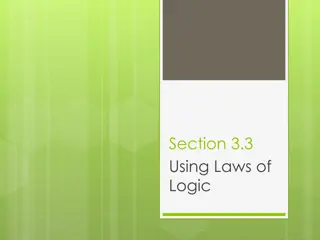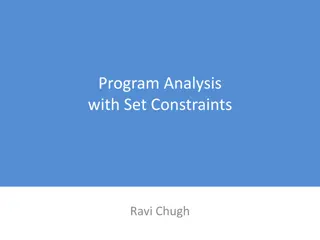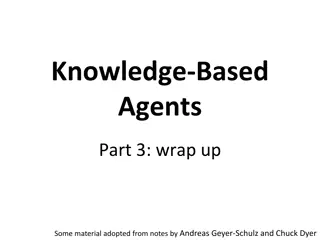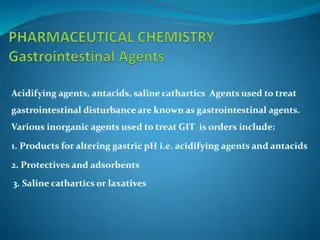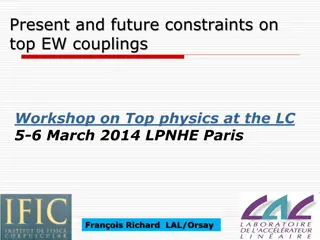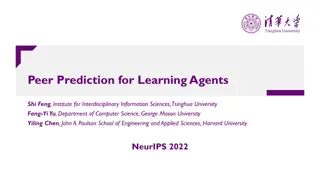Logical Agents and Constraints in AI
Logical agents in AI rely on constraints to deduce solutions. As the number of constraints increases, the number of possible solutions can either decrease, stay the same, or increase. This relationship is crucial for problem-solving and reasoning in AI systems.
Download Presentation

Please find below an Image/Link to download the presentation.
The content on the website is provided AS IS for your information and personal use only. It may not be sold, licensed, or shared on other websites without obtaining consent from the author. Download presentation by click this link. If you encounter any issues during the download, it is possible that the publisher has removed the file from their server.
E N D
Presentation Transcript
Warm-up: What is the relationship between number of constraints and number of possible solutions? In other words, as the number of the constraints increases, does the number of possible solutions: A) Increase B) Decrease C) Stay the same
Announcements Midterm 1 Exam Tue 10/1, in class Assignments: HW3 Due tonight, 10 pm HW4 Due Tue 9/24, 10 pm P2: Logic and Planning Out Thu 9/19 Due Thu 10/3, 10 pm Recitation and feedback survey on Piazza Due tomorrow, 10 pm Sat 10/5, 10 pm
AI: Representation and Problem Solving Propositional Logic Instructors: Pat Virtue & Fei Fang Slide credits: CMU AI, http://ai.berkeley.edu
Logical Agents Logical agents and environments Agent Environment Sensors Percepts Knowledge Base ? Inference Actuators Actions
Wumpus World Logical Reasoning as a CSP Bij = breeze felt Sij = stench smelt Pij = pit here Wij = wumpus here G = gold http://thiagodnf.github.io/wumpus-world-simulator/
A Knowledge-based Agent functionKB-AGENT(percept) returnsan action persistent: KB, a knowledge base t, an integer, initially 0 TELL(KB, PROCESS-PERCEPT(percept, t)) action ASK(KB, PROCESS-QUERY(t)) TELL(KB, PROCESS-RESULT(action, t)) t t+1 returnaction
Logical Agents So what do we TELL our knowledge base (KB)? Facts (sentences) The grass is green The sky is blue Rules (sentences) Eating too much candy makes you sick When you re sick you don t go to school Percepts and Actions (sentences) Pat ate too much candy today What happens when we ASK the agent? Inference new sentences created from old Pat is not going to school today
Logical Agents Sherlock Agent Really good knowledge base Evidence Understanding of how the world works (physics, chemistry, sociology) Really good inference Skills of deduction It s elementary my dear Watson Dr. Strange? Alan Turing? Kahn?
Worlds What are we trying to figure out? Who, what, when, where, why Time: past, present, future Actions, strategy Partially observable? Ghosts, Walls Which world are we living in?
Models How do we represent possible worlds with models and knowledge bases? How do we then do inference with these representations?
Wumpus World Possible Models P1,2 P2,2 P3,1
Wumpus World Possible Models P1,2 P2,2 P3,1 Knowledge base Nothing in [1,1] Breeze in [2,1]
Wumpus World Possible Models P1,2 P2,2 P3,1 Knowledge base Nothing in [1,1] Breeze in [2,1] Query ?1: No pit in [1,2]
Wumpus World Possible Models P1,2 P2,2 P3,1 Knowledge base Nothing in [1,1] Breeze in [2,1] Query ?2: No pit in [2,2]
Logic Language Natural language? Propositional logic Syntax: P ( Q R); X1 (Raining Sunny) Possible world: {P=true, Q=true, R=false, S=true} or 1101 Semantics: is true in a world iff is true and is true (etc.) First-order logic Syntax: x y P(x,y) Q(Joe,f(x)) f(x)=f(y) Possible world: Objects o1, o2, o3; P holds for <o1,o2>; Q holds for <o3>; f(o1)=o1; Joe=o3; etc. Semantics: ( ) is true in a world if =oj and holds for oj; etc.
Piazza Poll 1 If we know that ? ? and ? ? are true, what do we know about ? ?? ? ? is guaranteed to be true ? ? is guaranteed to be false i. ii. iii. We don t have enough information to say anything definitive about ? ?
Piazza Poll 2 If we know that ? ? and ? ? are true, what do we know about ?? ? is guaranteed to be true ? is guaranteed to be false i. ii. iii. We don t have enough information to say anything definitive about ?
Piazza Poll 1 If we know that ? ? and ? ? are true, what do we know about ? ?? ? ? ? ? ? ? ? ? ? false false false false true false false false true false true true false true false true false false false true true true true true true false false true true true true false true true true true true true false true false true true true true true true true
Piazza Poll 1 If we know that ? ? and ? ? are true, what do we know about ? ?? ? ? ? ? ? ? ? ? ? false false false false true false false false true false true true false true false true false false false true true true true true true false false true true true true false true true true true true true false true false true true true true true true true
Piazza Poll 2 If we know that ? ? and ? ? are true, what do we know about ?? ? ? ? ? ? ? ? ? ? false false false false true false false false true false true true false true false true false false false true true true true true true false false true true true true false true true true true true true false true false true true true true true true true
Propositional Logic Symbol: Variable that can be true or false We ll try to use capital letters, e.g. A, B, P1,2 Often include True and False Operators: A: not A A B: A and B (conjunction) A B: A or B (disjunction) Note: this is not an exclusive or A B: A implies B (implication). If A then B A B: A if and only if B (biconditional) Sentences
Propositional Logic Syntax Given: a set of proposition symbols {X1, X2, , Xn} (we often add True and False for convenience) Xi is a sentence If is a sentence then is a sentence If and are sentences then is a sentence If and are sentences then is a sentence If and are sentences then is a sentence If and are sentences then is a sentence And p.s. there are no other sentences!
Notes on Operators ? ? is inclusive or, not exclusive
Truth Tables ? ? is inclusive or, not exclusive ? ? ? ? ? ? ? ? F F F F F F F T T F T F T F T T F F T T T T T T
Notes on Operators ? ? is inclusive or, not exclusive ? ? is equivalent to ? ? Says who?
Truth Tables ? ? is equivalent to ? ? ? ? ? ? ? ? ? F F T T T F T T T T T F F F F T T T F T
Notes on Operators ? ? is inclusive or, not exclusive ? ? is equivalent to ? ? Says who? ? ? is equivalent to (? ?) (? ?) Prove it!
Truth Tables ? ? is equivalent to (? ?) (? ?) ? ? ? ? ? ? (? ?) (? ?) ? ? F F T T T T F T F T F F T F F F T F T T T T T T Equivalence: it s true in all models. Expressed as a logical sentence: (? ?) [(? ?) (? ?)]
Propositional Logical Vocab Literal Atomic sentence: True, False, Symbol, Symbol Vocab Alert! Clause Disjunction of literals: ? ? ? Definite clause Disjunction of literals, exactly one is positive ? ? ? Horn clause Disjunction of literals, at most one is positive All definite clauses are Horn clauses
Propositional Logic Check if sentence is true in given model In other words, does the model satisfy the sentence? function PL-TRUE?( ,model) returns true or false if is a symbol thenreturnLookup( , model) if Op( ) = thenreturn not(PL-TRUE?(Arg1( ),model)) if Op( ) = thenreturn and(PL-TRUE?(Arg1( ),model), PL-TRUE?(Arg2( ),model)) etc. (Sometimes called recursion over syntax )
Warm-up: What is the relationship between number of constraints and number of possible solutions? In other words, as the number of the constraints increases, does the number of possible solutions: A) Increase B) Decrease C) Stay the same Where is the knowledge in our CSPs?
Piazza Poll 3 What is the relationship between the size of the knowledge base and number of satisfiable models? In other words, as the number of the knowledge base rules increases, does the number of satisfiable models: A) Increase B) Decrease C) Stay the same
Piazza Poll 3 What is the relationship between the size of the knowledge base and number of satisfiable models? In other words, as the number of the knowledge base rules increases, does the number of satisfiable models: A) Increase B) Decrease C) Stay the same
Sentences as Constraints Adding a sentence to our knowledge base constrains the number of possible models: P Q R Possible Models false false false KB: Nothing false false true false true false false true true true false false true false true true true false true true true
Sentences as Constraints Adding a sentence to our knowledge base constrains the number of possible models: P Q R Possible Models false false false KB: Nothing KB: [(P Q) (Q P)] R false false true false true false false true true true false false true false true true true false true true true
Sentences as Constraints Adding a sentence to our knowledge base constrains the number of possible models: P Q R Possible Models false false false KB: Nothing KB: [(P Q) (Q P)] R KB: R, [(P Q) (Q P)] R false false true false true false false true true true false false true false true true true false true true true
Sherlock Entailment When you have eliminated the impossible, whatever remains, however improbable, must be the truth Sherlock Holmes via Sir Arthur Conan Doyle (Not quite) Knowledge base and inference allow us to remove impossible models, helping us to see what is true in all of the remaining models
Wumpus World Possible Models P1,2 P2,2 P3,1 Knowledge base Breeze Adjacent Pit Nothing in [1,1] Breeze in [2,1]
Wumpus World Possible Models P1,2 P2,2 P3,1 Knowledge base Breeze Adjacent Pit Nothing in [1,1] Breeze in [2,1] Query ?1: No pit in [1,2]
Wumpus World Possible Models P1,2 P2,2 P3,1 Knowledge base Breeze Adjacent Pit Nothing in [1,1] Breeze in [2,1] Query ?2: No pit in [2,2]
Entailment Entailment: |= ( entails or follows from ) iff in every world where is true, is also true I.e., the -worlds are a subset of the -worlds [models( ) models( )] Usually we want to know if KB |= query models(KB) models(query) In other words KB removes all impossible models (any model where KB is false) If is true in all of these remaining models, we conclude that must be true Entailment and implication are very much related However, entailment relates two sentences, while an implication is itself a sentence (usually derived via inference to show entailment)
Wumpus World Possible Models P1,2 P2,2 P3,1 Knowledge base Breeze Adjacent Pit Nothing in [1,1] Breeze in [2,1] Entailment: KB |= ? KB entails ? iff in every world where KB is true, ? is also true
Wumpus World Possible Models P1,2 P2,2 P3,1 Knowledge base Breeze Adjacent Pit Nothing in [1,1] Breeze in [2,1] Query ?1: Entailment: KB |= ? KB entails ? iff in every world where KB is true, ? is also true No pit in [1,2]
Wumpus World Possible Models P1,2 P2,2 P3,1 Knowledge base Breeze Adjacent Pit Nothing in [1,1] Breeze in [2,1] Query ?2: Entailment: KB |= ? KB entails ? iff in every world where KB is true, ? is also true No pit in [2,2]
Propositional Logic Models All Possible Models A B C 0 0 0 0 0 1 0 1 0 0 1 1 1 0 0 1 0 1 1 1 0 1 1 1 Model Symbols
Entailment: |= entails iff in every world where is true, is also true Piazza Poll 4 Does the KB entail query C? All Possible Models A B C 0 0 0 0 0 1 0 1 0 0 1 1 1 0 0 1 0 1 1 1 0 1 1 1 Model Symbols A 0 1 0 1 0 0 0 1 1 1 1 1 1 0 1 1 B C Knowledge Base A B C 1 1 1 1 0 1 1 1 Query C 0 1 0 1 0 1 0 1
Entailment: |= entails iff in every world where is true, is also true Piazza Poll 4 Does the KB entail query C? All Possible Models A B C 0 0 0 0 0 1 0 1 0 0 1 1 1 0 0 1 0 1 1 1 0 1 1 1 Model Symbols A 0 1 0 1 0 0 0 1 1 1 1 1 1 0 1 1 B C Knowledge Base A B C 1 1 1 1 0 1 1 1 Query C 0 1 0 1 0 1 0 1
Entailment How do we implement a logical agent that proves entailment? Logic language Propositional logic First order logic Knowledge Base Add known logical rules and facts Inference algorithms Theorem proving Model checking
Simple Model Checking functionTT-ENTAILS?(KB, ) returnstrue or false




